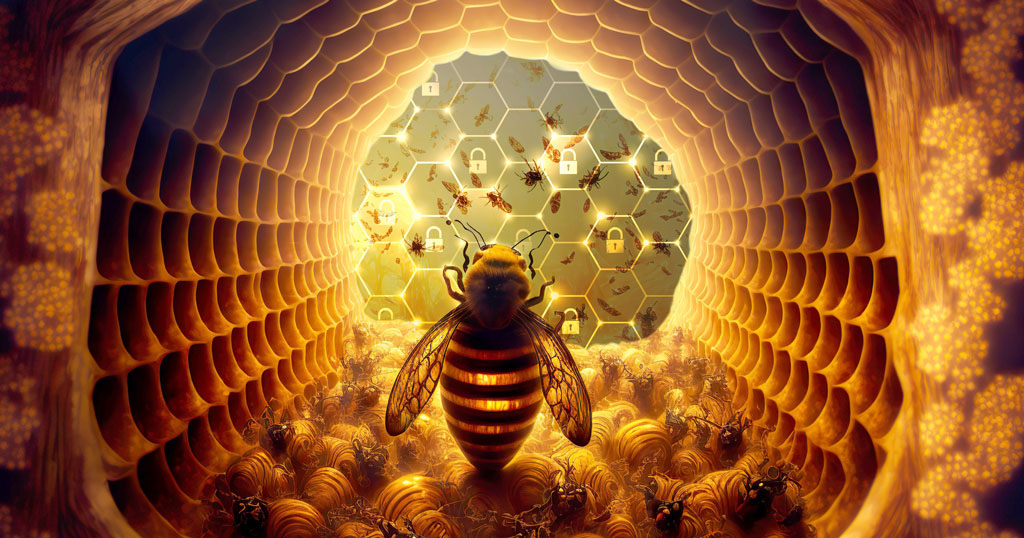Our world is a complex, interdependent system, and invertebrate pollinators such as honeybees play a pivotal role in its survival. Threats to populations numbers of pollinators like honeybees can be equated to threats to the overall health and survival of the ecosystem in which they live. Of the over 20,000 known bee species, one—the western honeybee (Apis mellifera)—acts as the single most frequent pollinator for crops worldwide (1). Found on every continent except Antarctica, the western honeybee owes its status as a top pollinator to its widespread geographic distribution, generalist foraging behavior and competence as pollinators (1).

Deadly American Foulbrood Disease
Honeybees are the most economically valuable pollinators and are threatened by several pathogens (2). Perhaps the biggest threat to honeybee colony health and survival is the bacterial disease, American Foulbrood (AFB; (3). Caused by the spore-forming, Gram+ bacteria, Paenibacillus larvae, the highly contagious AFB disease affects the young brood of colonies. When newly hatched larvae are fed spore-contaminated food, the spores germinate and replicate causing septicemia and death. P. larvae spores are incredibly resilient and can remain viable for decades (3). Each infected larva can produce over 1 billion new spores. Thus, a colony can produce large numbers of spores with just a few cases of symptomatic brood (4).
AFB is difficult to control because symptoms are only detected when the colony cleaning behaviors can no longer keep up with the spread of the disease. By this point, it is highly likely that the infectious spores have been dispersed outside the infected colony by forager bees, through swarming and robbing, or through beekeepers moving contaminated material between colonies (3).
P. larvae spores are resistant to both environmental conditions and chemical treatments, making AFB difficult to eradicate. Once the disease is detected, the bees, hives and equipment need to be burned to prevent further spread (2). Preventative management through prophylactic feeding of antibiotics is not practical, and in many regions of the world this type of antibiotic use in livestock (including bees) is not permitted (2). With as many as 25% of infected colonies going undetected (3), there is an urgent need for safe and sustainable methods for protecting bee colony health.
Insect Immunity and Trans-Generational Immune Priming
The immune system of invertebrates such as insects lack antibodies and do not use the same immune mechanisms as vertebrates (2). This means that methods used in other animals to elicit a protective immune response won’t work the same way in invertebrates. However, insects do produce immune effectors that will generate a functional immune response following pathogen exposure (5). Remarkably, this immune response ‘memory’ of pathogen exposure can be transferred from one generation to the next. This phenomenon—called Trans-generational Immune Priming (TFIP)—results in vertical transmission of immune elicitors from the parent(s) to the offspring (5,6). Although the mechanisms that support TGIP are still not fully understood, we do know that one molecular avenue for TGIP involves the egg-yolk protein, vitellogenin (Vg). In Vg-modulated TGIP, Vg binds bacteria and transfers pieces of the pathogen into the eggs, which then produces an immune response in the developing larvae (7).
Inoculating the Queen
Identifying the Vg’s role in TGIP has proven pivotal to finding safe and effective ways to prophylactically treat bee colonies for P. larvae. In December 2022, The US Department of Agriculture (USDA) granted a conditional license to the biotech company Dalan Animal Health for their vaccine against AFB disease. The oral vaccine works by feeding queens royal jelly containing inactivated P. larvae. Vg-mediated TGIP results in the next generation of larvae displaying an increased resistance to infection with P. larvae spores. The effectiveness of the vaccine was highlighted in research published in Frontiers in Veterinary Science (2). The research showed that feeding queens royal jelly containing inactivated P. larvae resulted in up to a 50% increase in resistance to P. larvae spores even when challenged using spores from a strain that differed from the vaccine strain (2).
Although methods such as injecting heat-killed P. larvae have also been effective, this method is not practical for several reasons including the potential injury to the queen, the highly manual application required and the inability of this method to be used under natural conditions. Not only is oral inoculation more practical for insect populations, it is also how most natural bacterial pathogenic infections are introduced (7).
Protecting Honeybee Health
Honeybees are social insects that live in well-organized colony units. When it comes to AFB, this strength is also a weakness. The highly contagious nature of AFB, combined with the communal nature of colony life, means infection ultimately results in colony death. Couple these with the difficulty in identifying early infection within a colony and the best hope for protecting colony health becomes protecting it from infection. By leveraging our understanding of TGIP in honeybees, the recently introduced AFB vaccine offers a first step to protecting important pollinator insect species such as the honeybee from devastating environmental pathogens.
References
- Garibaldie, L.A. et al. (2013) Science 229, 1608–11.
- Dickel, F. et al. (2022) Front. Vet. Sci. 9, 946237.
- Stephan, J.G. et al. (2020) BMC Ecology 20, 15.
- Zabrodski, M.W. et al. (2020) Can. Vet. J. 61, 1055–9.
- Pigeault, R. (2016) Proc. R. Soc. B 283, 20161136.
- Tetreau, G. et al. (2019) Fron. Immunol. 10, 1938.
- Salmela. H. et al. (2015). PLoS Pathog 11, e1005015.
